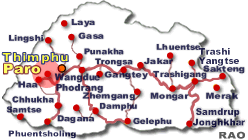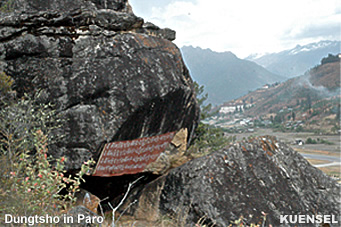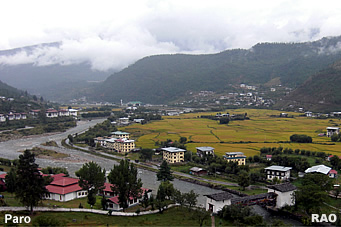| Bhutan
- Ethnic Groups & People |
 |
Bhutan's
People |
 |
Bhutan Information |
|
|
 |
|
Blacksmiths: The Sword that rides the Wind
|

|
 |
| Every time the chisel hit the blade, the sword oscillated. Looking more carefully, he noticed the craftsman was engraving a juxtaposed dorji or vajra on the blade. Immediately, he knew that it belonged to the royal household. He had never seen such a thin and light sword. It is known as Lungdri Chenm - the sword that rides the wind and its history is rooted in mythology. |
|
Many
blacksmiths in the east still practice the tradition of zokor, an age-old
custom where blacksmiths move from place to place in search of work and
Karma Tshering is one of them.
According
to Karma Tshering, his ancestors had practiced the tradition and his father
continued the trend. "I used to accompany my father when he traveled from
one village to another and at the age of 15, I started to move on my own,"
the 28-year old blacksmith said.
 |
| One of Dupthob Gaw Janka Lap’s dungtshos in Paro |
| Every time the chisel hit the blade, the sword oscillated. Looking more carefully, he noticed the craftsman was engraving a juxtaposed dorji or vajra on the blade. Immediately, he knew that it belonged to the royal household. He had never seen such a thin and light sword. It is known as Lungdri Chenm - the sword that rides the wind and its history is rooted in mythology. |
|
The Sword
What sets the Lungdri Chenm apart from other Bhutanese swords? It is ultra thin, light and yet resilient. It is flexible and can be bent to its hilt. When you swing it, the blade oscillates. It is said that it is so sharp that you can slice an object in half without even knowing. Because of these features, you cannot strike it like an ordinary sword. It has to be struck outwards rather than inwards, and one has to have the presence of the mind to study the movement of the wind and let it ride it. The other salient feature is that the tip is always pointed upwards.
The Master Swordsmith
Old blacksmiths in the country believe that the man, who forged it was an adept in the guise of a blacksmith. They believe that he lived in Chimi Thangkha village in the outskirts of Thimphu. It is said that he forged this unusual sword for the penlop or local governor of the area.
As the story goes, one day after labouring for many days, satisfied with the workmanship, he offered the sword to the penlop, saying, ‘If you strike an object with this sword, you won’t even know if you hit it." The governor looked at it and said, 2If it so good let me try it on you." Seeing him still standing, the disappointed chief accused the swordsmith of lying. 2You are a liar, see nothing happened." At that moment, Dupthob Jangkha Lap moved and he fell into two.
 |
| There are no written records, only oral stories on the sword and its smith. It is believed that the adept moved from cave to cave, not only extracting iron ore but also forging swords, knives and ritual objects. The blacksmiths of the country revere the Drupthob as the master swordsmith. In their world the ultimate compliment is, 2Like Gaw Jang Ka Lap, you cannot only extract iron ore but also can forge them into fine swords." |
|
Unlike, the 15th century bridge builder, Dupthob Thangtong Geylpo, who is believed to have used his knee as an anvil to cast his wares, this blacksmith had anvils commonly as tempurs in Dzongkha. On the Druk Path trek, you can see one in a cave below Pumla on the way to Paro.
Outside the world of blacksmiths, common people consider these caves sacred and visit them on pilgrimages. It is believed that he travelled to Paro and one of his dungtshos (mines) can still be seen opposite the airport in Paro (see photo).
One of the oldest living court official recounts his days at the court looking after swords of the second king. Dasho Boto Karp (93) said his master had two boxes of swords, which he had to polish almost every day. They were stored in heavy wooden boxes that required two people to carry it.
Each box contained about 14-15 old swords. The king had inherited it from his father. Each sword was wrapped in cloth and labelled accordingly. According to him, the king would often inspect them and frequently clean all the swords himself. The swords were mainly Chukha Tenzing, Pasang Tenzing, Ja dre Chenm, Bu dre Chenm. However, he said he never saw Lungdri Chenm and only heard stories of it.
Gaw Phaju (69), the country’s oldest blacksmith, has made a few imitations; since he had never seen it and he had to rely on his imagination to forge them. In his words, 2They must have been made of spring steel rather than the stiff carbon steel of swords intended for cutting or sparring." He said his imitations couldn’t be used like the real ones, as they twist when struck and break when bent to the hilt.
Today, it is believed that three of these fine swords exist in the country. The first one is believed to be hanging on the walls of the Dechenphodrang monastery in Thimphu. The other can be seen in another monastery in Punakha. The statue of the protecting deity of the Talo monastery, the Talo Gyalp is supposed to be holding it in his right hand.
Because these two swords are kept in the inner sanctum of the altars where admission is restricted, we do not know for sure if the swords actually exist. The third sword belongs to the royal household. One senior court official, who has seen it, said that it is shorter than normal ones, thinner and has three grooves in it. In the words of the official, it belonged to the first king.
It is not established if any of the three swords was forged by Dupthob Gaw Janka Lap.
| Contributed
by Tshering Tashi, Kuensel, Bhutan's National Newspaper, 2011 |
 |
top
| Information on Bhutan |
 |
|




